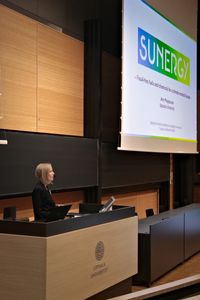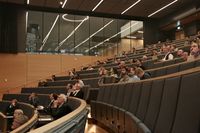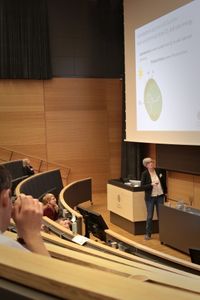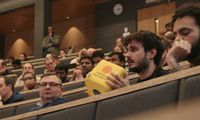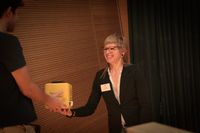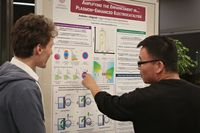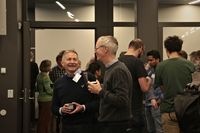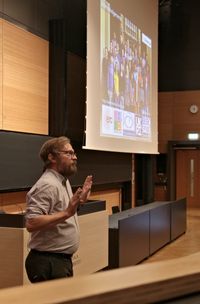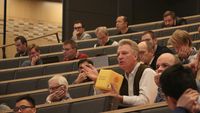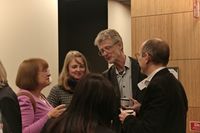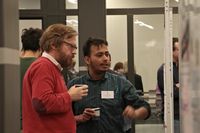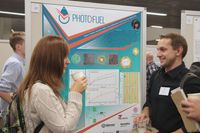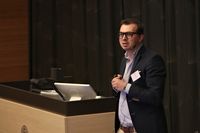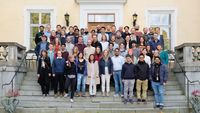Upcoming seminars and events
October 29: CAP Workshop on advanced renewable fuels for defossilisation of the energy sector
Time: 13:15 - 16:30 (ca.)
Place: Sonja Lyttkens lecture hall, Ångström laboratory
Participation is free, but we ask you to register via this link!
Program: | |
13:15 | Welcome |
13:25 | “Innovative chemical approaches to defossilized fuels” - Sascha Ott |
14:00 | “Local circular hydrogen production in Uppsala” - Rafael Waters |
14:35 | Break |
14:50 | Charlotte Platzer Björkman |
15:25 | "Hydrogen in transition metal compounds - novel analytical approaches providing atomic scale understanding" - Daniel Primetzhofer & Gunnar Karl Pálsson |
16:00 | "Green cell factories for production of solar chemicals and fuels” - Pia Lindberg |
16:35 | End |
Previous news and events
October 24 - 26, 2023: Uppsala University conference on Sunlight- and Power-to-X
in collaboration with SUNERGY, CAP organized a conference on research and innovation on sustainable fossil-free fuels and base chemicals, with focus on technologies for direct H2 production and CO2 valorization from renewable energy.
The conference was attended by more than 170 people: researchers, company representatives, policymakers, and other interested parties came together during these three days of presentations aimed at accelerating the development of solar fuels, electro-fuels, and sustainable base chemicals in Sweden and in Europe. There was also a poster exhibition where PhD students and postdocs presented their work.
Read a summary about it on the SUNERGY webpage!
The meeting programme can be downloaded here:
Stefano Crespi awarded the Gustafsson prize!
The Göran Gustafsson prize in physics is awarded to the CAP member Stefano Crespi. His research is focused on the design of new photochemical reactions and to find new ways to utilize light stimuli and convert them into mechanical motion on the nanometer scale, to design new light-driven molecular machines. The prize is a research grant of 2,75 MSEK.
Read more on the home page of the Göran Gustafssons stiftelse (Swedish).
Alina Sekretareva awarded the Gustafsson prize in physics
The Göran Gustafsson prize in physics at Uppsala university is awarded to the CAP member Alina Sekretareva. Her research is focused on electron transfer processes within (bio)electrocatalysts and on the electrode/catalyst interface, and exploring novel concepts for new electrocatalytic devices. The prize is a research grant of 2,75 MSEK.
Read more on the home page of the Göran Gustafssons stiftelse (Swedish).
The CAP workshop, September 27 - 28, 2022
The 2022 edition of the CAP workshop at Haga Slott (Enköping) was a great event!
CAP co-organizer of the Energy Theme day on May 19, 2022
A multidisciplinary theme week took place between 16-20 May on topics in science and technology at the Ångström Laboratory. During this week, current research within AI/Data-driven life science, the Universe and Mathematical Physics, Material, Energy and Climate change was presented by scientists and invited speakers from industry and other parts of society.
CAP co-organized the session on solar energy and solar fuels in the afternoon, with the following contributions:
• Marika Edoff, Uppsala University, Solve: Solelforskningscentrum Sverige - a new excellence centre.
• Solar Power in Sweden: Growth and future prospects
• Per Sundell, Vattenfall: Sustainable aviation fuel from CO2
• Pietro Campana, Mälardalen University: Combining photovoltaics and agriculture to agrivoltaics - sustainable land sharing
• Ellen Moons, Karlstad University: Research for efficient and stable new solar cells
• Leif Hammarström, Uppsala University: Solar fuel, an international overview
• Pia Lindberg, Uppsala University: Gren cell factories, fuels and chemicals from CO2 and solar energy
Chairs Marika Edoff and Peter Lindblad.
SUNERGY Sweden Event
On 20th of April, 2021, 60+ participants joined the SUNERGY online event for Sweden. A dedicated meeting for Sweden that was organized in the run-up to the upcoming calls of the 2021-2022 Horizon Europe work programme and the SUNERGY – CO2 Value Europe joint brokerage event. The meeting was opened by Ann Magnuson, introducing the SUNERGY vision of enabling a fossil-free Europe through research and innovation. The event emphasized the important role that Sweden can play in this with its strong profile in renewable energy R&D.
Watch all the presentations on YouTube:
Soap bubbles on the rise
A research project led by Leif Hammarström at Uppsala University has been awarded a EUR 3.2 million grant by the European Commission. The aim is to create renewable solar fuel using soap foam, carbon dioxide and sunlight.
SoFiA (Soap Film-based Artificial Photosynthesis) aims to build a small-scale demonstrator device that will be able to produce solar fuels and raw materials for chemical industries using only sunlight, water and CO2. The SoFiA concept mimics the thylakoid membrane in leaves and uses molecular catalysts made from earth abundant materials, to form self-assembled photo catalytic surfaces with designed soap foams. Read more on the project webpage.
Haining Tian doubly awarded in 2019 and 2020
Haining Tian was awarded the prestigious Göran Gustafsson Prize in 2020, and also was awarded Wallenberg Academy Fellow in Engineering and Technology 2019, for his work on catalysis and solar fuels.
Read more about Haining at the Knut and Alice Wallenberg Foundation webpage, and on the Tian group webpage.
Shedding new light on greener synthesis pathways
In October 2019, Sascha Ott, Eszter Borbas, Leif Hammarström and Jacinto Sá, received a 5-year grant of 35 million kronor from the Knut and Alice Wallenberg Foundation, for their interdisciplinary project "Unexplored Approaches to Organic Photoredox Catalysis”.
In this new research project, the groups will focus on finding new alternatives to several reactions that are widely used in the chemical industry. The objective is to develop new synthesis pathways that generate less waste, or new synthetic routes that previously have been unfeasible.
The CAP workshop 2018
Our annual workshop was held in 2018 at Sigtunahöjden in Sigtuna, on April 26-27. Thanks for all the interesting presentations everyone, you made the workshop great!
©CAP 2023


